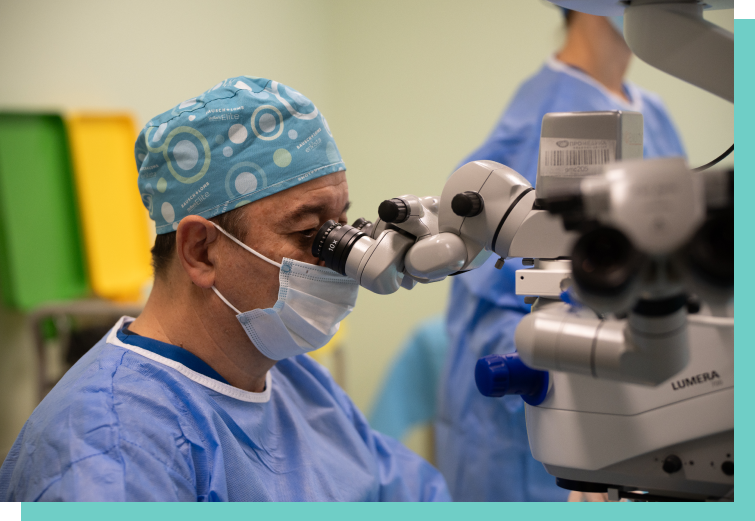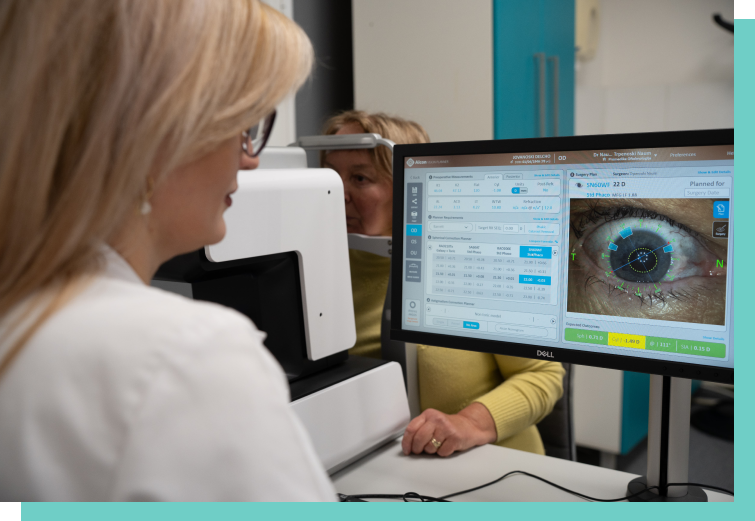LEARN MORE ABOUT CATARACTS
A cataract is a clouding of the natural lens in the eye. People who have cataracts describe their vision as looking through a “curtain” or through a frosted or fogged window.
Definition of cataract
A cataract is a clouding of the natural lens in the eye. People who have cataracts describe their vision as looking through a “curtain” or through a frosted or fogged window. This blurred vision can make it difficult to perform everyday activities, such as reading, driving (especially at night), and even recognizing friends’ faces.
Cataracts usually develop slowly and may not impair your vision at first. However, over time, as the cataract matures, your vision will become increasingly impaired.
Causes of cataracts
The causes of cataracts are not yet fully understood. It is believed that there are factors that can influence the occurrence of this disease:
gender (develops more often in women);
long-term use of drugs from the corticosteroid group;
long-term and frequent consumption of alcohol and cigarettes;
high exposure to solar and radiation radiation;
obesity;
diabetes;
previous eye injuries and inflammation of the internal structures of the eye.
Types of cataracts
There are many types of cataracts, of which the most common are:
CONGENITAL CATARACT – Occurs in children mainly as a result of an infection the mother had during pregnancy.
TRAUMATIC CATARACT – Occurs as a result of open or closed injuries to the eye. It can occur as part of some inflammatory eye diseases, long-term use of certain medications (most often corticosteroids), or as a result of some eye surgeries (e.g. glaucoma or retinal ablation), which are rarely the cause.
SENIERIAL CATARACT – This is the most common form of cataract that occurs mainly in people over the age of 55. It is characterized by clouding and hardening of the lens, which causes decreased vision, but often also myopia in people who usually have normal vision, and in nearsighted people, it reduces farsightedness.


Cataract symptoms
Some of the basic symptoms that indicate the presence of cataracts are:
blurred vision;
change in color perception (seeing blue);
seeing double;
poor night vision
especially when driving at night;
light sensitivity;
white or gray pupil.
Cataracts usually progress slowly, but in some rare cases they can develop rapidly. In some cases, the progression of cataracts may only manifest itself in a decrease in the sharpness of distant vision, which occurs as a result of the thickening of the lens. At this stage, the problem can be temporarily solved by increasing the diopter of the glasses or by using stronger lighting or a magnifying glass. However, as the disease develops, the lens begins to turn yellow or white, and vision becomes increasingly weaker, so it becomes obvious that glasses with increased diopters, as well as stronger lighting or a magnifying glass will not solve the problem.
Cataract treatment
Once a cataract has developed, it cannot be cured with eye drops, prescription glasses, or a special diet. Cataracts can only be removed surgically. Using an ultrasound device, the cloudy lens is removed and a specially designed, flexible artificial lens, called an intraocular lens, is implanted in its place, which remains permanently in the eye.
Cataracts develop individually over time, from several months to several years. It used to be believed that cataract surgery should be waited until its final stage, when the patient is no longer able to function independently. Fortunately, this outdated view has been overcome. In fact, as the disease progresses, the lens in the eye becomes harder and harder to remove. Also, in more mature cataracts, it is necessary to use a higher intensity of ultrasound, which can damage the surrounding tissues, especially the cornea. Such an operation takes longer, and therefore the recovery process of the cornea is also longer.
- We have the best prices compared to the competition.
- Modern and latest technology and equipment
- 3D operating system
- The pre-operative examination package is not included in the price of the surgery and costs 4,200 denars . The examinations are as follows :
- Refraction
- Determining visual acuity
- Eye pressure measurement
- Fundus examination
- Echo biometrics
- IOL master
- OCT examination
- Anesthesiology examination, which is not included in the price of the surgery, costs 1,500 denars.
Explanation
With Monofocal intraocular lenses (spherical – white round, aspherical white – flat and aspherical yellow – flat), the patient achieves good distance vision , but for near vision they will need to wear glasses.
With the Multifocal EDOF lenses with extended focus, the patient gets good distance vision and good near vision at 50 cm.
With Multifocal-Trifocal intraocular lenses, the patient gains good distance vision , as well as good near vision at 40cm and 70cm .
The human natural lens has a natural filtering function. During the surgical procedure, the human natural lens is removed and an artificial lens is inserted. An intraocular lens that has a blue filter replaces this function (it is the yellow lens). Yellow intraocular lenses protect the back of the eye from harmful blue light.
What do you need to know before surgery?
Every patient who decides to undergo cataract surgery needs to undergo several examinations before surgery.
1. LABORATORY TESTS and ECG
Basic blood count with glycemia that should not be older than 30 days.
Note: If the patient is receiving prostate therapy (FLOMAX) which is an alpha blocker and its generic name is Tamsulosin (Tanyz) or another natural preparation, he must inform the doctor who will perform the surgery about it, because in these patients, due to the use of the above-mentioned drugs, the pupil dilation is prevented. (This refers to all patients who have ever received this drug for more than a month.) Therefore, it is necessary to apply a mechanical pupillary dilator (surgical ring) intraoperatively in order to mechanically dilate the pupil during the surgical procedure. The surgical ring that is implanted costs 12,000 denars.
2. PREPARATION
Two days before the scheduled surgery, Tobradex 4×1 drops are instilled or every 4 hours at 8:00 AM; 12:00 PM; 4:00 PM; 8:00 PM in the eye to be operated on. Also, those patients who are receiving anti-glaucomatous therapy (eye pressure therapy) need to continue it and not interrupt it either before or after cataract surgery.
3. THE DAY OF OPERATION
For cataract surgery, the patient is expected to stay in the hospital for 2-4 hours (time required for patient preparation, which does not include lying in a hospital bed and hospital room)
It is advisable for the patient to eat a light breakfast on the day of surgery.
If the patient has been prescribed regular chronic therapy, he/she needs to drink it as every normal day. If you are taking tab. Aspirin, stop 5 days before the surgery. If you are receiving anticoagulant therapy or therapy according to a scheme, you will need to consult a hematologist to prescribe Clexane therapy. Cataract surgery is short and lasts 10-15 minutes and is performed with local anesthesia ( drops ) and is painless .
4. HOW TO BEHAVE AFTER CATARACT SURGERY WITH THE PHACO METHOD
The patient removes the bandage from the eye at 6 p.m. and the eye no longer closes.
After removing the bandage, postoperative therapy begins on the same day. Tobradex 4×1 drops are placed in the operated eye at 6 p.m.; 7 p.m.; 8 p.m. and 9 p.m. From the next day, Tobradex 4×1 drops are continued again at 8 a.m.; 12 p.m.; 4 p.m. and 8 p.m. On the first day, it is normal for the patient to see blurry, have redness in the eye, and feel a slight stinging and slight pain in the eye.
If the patient is receiving anti-glaucomatous therapy (eye pressure therapy), it is mandatory to continue it as prescribed preoperatively. It is also necessary to continue with regular chronic therapy (diabetes, blood pressure, etc.).
A new diopter of the operated eye is determined one month after the operation, until then glasses with diopters are not worn. If you need to wear glasses, the glass of the operated eye should be changed to a glass without diopters, which you can also change in our optics. The price depends on the anti-reflective of the other glass, (350 den; 750 den; or 1500 den.) You can wear sunglasses if you want.
No water should enter the eye for the next 10 days, meaning the patient can wash their face normally but do so with their eyes closed.
Steaming, watching television, and moderate weight lifting are permitted.
IMPORTANT
The price of the surgery includes the first control examination, which is on the first day after the surgery. The examination that is after 30 days, i.e. the postoperative monthly control during which the diopter is determined, is charged 1,400 den and is performed by our team of doctors from Promedika Ophthalmology, and the diopter is determined by one of our specialists.
A first check-up can also be performed at centers near you at Sistina Ophthalmology in Bitola, Kumanovo, Tetovo, Shtip and will cost 800 den!